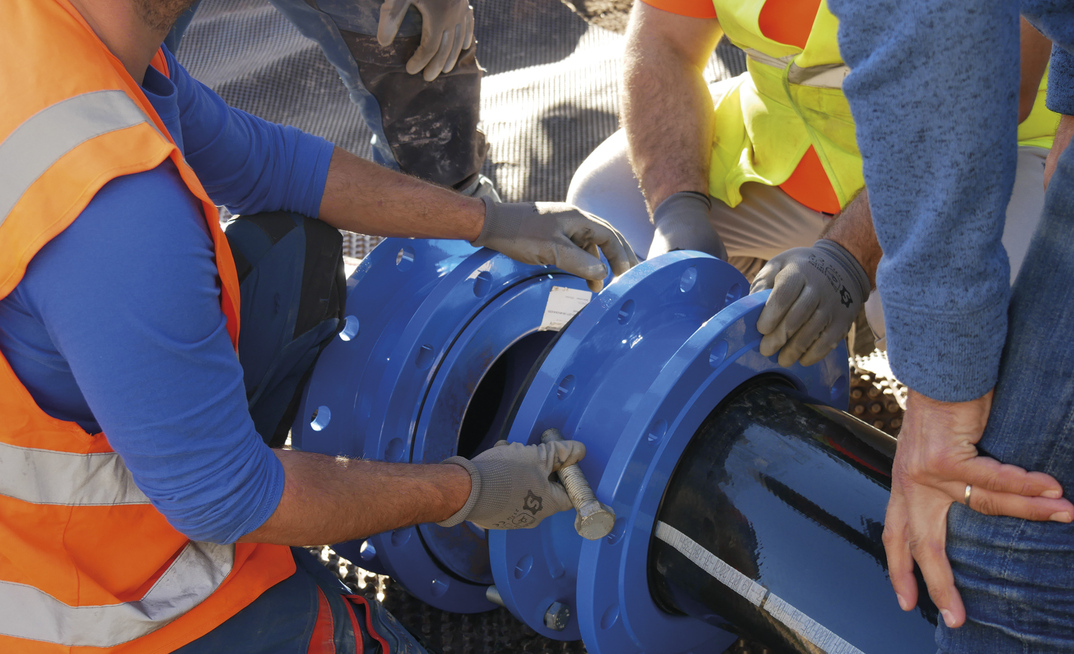Whether as a bypass during rehabilitation work on a pipeline whose operation must nevertheless continue, or as a pipeline for the temporary above-ground transport of large quantities of fluids in the oil and gas industry: Primus Line® Overland Piping is a safe and reliable solution of these cases. As different as the fields of application are, Primus Line® Overland Piping - consisting of a flexible pipeline and special connectors - convinces customers with the following benefits:
Safety
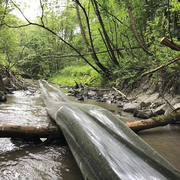
All-terrain: Due to its flexibility, Primus Line® Overland Piping naturally adapts to the ground.
Both the inner and outer layers of the high-pressure pipeline are made of thermoplastic polyurethane (TPU). These two layers are reinforced by a core of seamlessly woven aramid. This synthetic fibre impresses by its strength: It is five times higher than that of steel and twice that of glass fibre or nylon. The aramid fabric makes the pipeline flexible and, in combination with the TPU layers, safe at the same time: Based on the standard API 15LF, the burst pressure is at least two and a half times higher than the permissible operating pressure. Its three-layer structure with the resulting resistance distinguishes Primus Line® Overland Piping from other systems, leads to a generally longer service life and ensures operation without leakage and environmental damage.
The resistance of the flexible pipeline also allows the Overland Piping system to be installed and operated at very low temperatures. It does not corrode and is protected from UV radiation by its black outer layer.
Leakproof end connectors complete the Primus Line® Overland Piping system. During installation, the assembly teams do not have to weld or handle hazardous materials.
The fact that the entire production process of the flexible pipeline is consistently monitored also contributes to safety. Sensors and cameras continuously capture the process parameters which form the basis for extensive control mechanisms for wall thickness and strength. Furthermore, each manufactured flexible pipeline undergoes a pressure test at the factory before delivery to the construction site.
Costs
Primus Line® Overland Piping can be reused several times. Depending on the diameter, up to 14,700 feet of flexible pipeline are delivered to the installation site on a single reel. In combination with the product's low dead weight, this saves storage and transport costs. The same amount of HDPE pipes requires about ten times more space. Compared to HDPE, the flexible pipeline exceeds the break-even point in terms of costs after only a few applications.
Efficiency
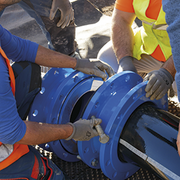
Welding not necessary: The assembly team mounts the connectors on site with hand-held tools.
As with all Primus Line products, installation lengths of up to 3,300 feet and more in one piece as well as multiple changes of direction are possible. The long lengths significantly reduce the number of joints - and thus potential weak points. Due to its flexibility, the pipeline adapts to the surface of the terrain.
The flexible pipeline handles large flow volumes of up to 132 gallons per second. It is laid directly from the reel to the ground using a winch, truck or mini-excavator. In contrast to HDPE pipes, installations of up to 19,700 feet per day are possible. The assembly team sets the connectors on site with hand-held tools.
Eco-friendliness
Primus Line® Overland Piping is installed with little equipment, either - as already mentioned - with a winch, truck or mini-excavator. This significantly reduces the carbon footprint on site. Heavy equipment is not required.
Sensitive and protected areas such as nature parks or river courses are not affected by installing the Primus Line® Overland Piping system.
System for various applications
Primus Line® Overland Piping has already been used in many areas and under a wide variety of conditions - whether in the municipal sector for wastewater, for transporting produced water in the oil and gas sector or as a brine transport pipeline in industry.
Wastewater bypass in Norway
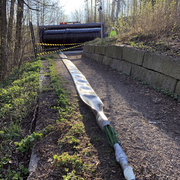
The motor-driven transport reel helps to quickly roll off and up again the flexible pipeline.
In Fossumbekken, an urban district of Oslo, a 36-/38-inch wastewater pipe had to be rehabilitated. For the seven-month rehabilitation period, the client, the Municipality of Oslo, and the contracted company, Primus Line installation partner Kjeldaas AS, were looking for an efficient and safe bypass solution. The easy and fast installation method as well as the reusability for other bypass projects convinced the end customer. In addition, the bypass ran through a difficult-to-access and ecologically sensitive area: The high product safety of the aramid-reinforced flexible pipeline was therefore crucial to protect the ecosystem.
The bypass had to cope with up to 79 gallons of wastewater per second. For this purpose, the rehabilitation experts of Kjeldaas AS installed two parallel pipelines with Primus Line® Overland Piping, each with a length of 3,445 feet. Both 12-inch aramid lines were operated at an operating pressure of 21.75 psi and only during the week while the actual construction work took place. At weekends and on days without construction work or during heavy rainfall, the existing pipeline was used. This approach enabled an optimal, fast and safe implementation of the project from both the economic and ecological point of view.
Above-ground transport for the transfer of produced water in Canada
A Canadian oil and gas producer had previously used temporary above-ground pipes made of HDPE for transporting the water produced, which has varying contents of hydrocarbons, chemicals and minerals, or transported the water by trucks. Due to the many joints, HDPE proved to be very time-consuming and the transport by trucks consumed a lot of fuel. After rigorous testing, the oil and gas producer chose Primus Line® Overland Piping as an alternative.
The special thing about this project was the installation at -22 °F. In this project, 20,340 feet of flexible 12-inch pipeline were laid in just one day.
During the eleven-day service period, the flexible pipeline transported more than 96 million gallons of produced water. According to the customer, the installation of Primus Line® Overland Piping saved around 7,000 truck tours to and fro and cut down the transport distance by around half, avoiding a total of more than 320 tonnes of CO2.
Bypass to transport brine in Southern France
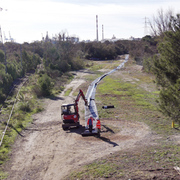
In the south of France, Primus Line® Overland Piping is laid out by means of a mini-excavator along a service road.
KEM ONE, one of Europe's largest vinyl producers, is currently rehabilitating a five-mile section of a transport pipeline for brine. In order to maintain the brine supply to the production plant in Fos-sur-Mer, the transport pipeline is being rehabilitated in sections of 3,280 feet. To do so, a bypass is used for every rehabilitation section. To prepare for installation, the assembly team mounted valves to obtain isolated sections of the same length. The Primus Line® system is used for both the rehabilitation and the bypass in this project. Thus, the assembly team uses the same flexible 12-inch pipeline eight times for the bypasses, with a length of around 3,280 feet. Each bypass is laid along the existing pipeline and service road.
The operator KEM ONE opted for the Primus Line® solution since the transport pipeline for the brine with a content of around 40 ounces of sodium chloride per gallon runs through the Natura 2000 protected area of the Camargue: safe transport and protection of the environment have the highest priority. In addition, according to the operator, this pipeline saves around 200 truckloads a day that would otherwise have to be transported between the saline in Vauvert and the plant in Fos-sur-Mer.
True alternative
Flexible and robust, all-terrain and reusable, quickly rolled off and up again, economical and environmentally friendly - Primus Line® Overland Piping offers to operators looking for a solution for the above-ground transport of fluids for a limited period of time a true alternative. Whose resilience has been proven by rigorous laboratory and field tests under the supervision of independent testing institutes.
| • Available sizes: | 6" up to 14" | |
| • Maximum operating pressure (MOP) following API 15LF for water transport on onshore oil fields at 68 °F (reduced performance at temperatures above 86 °F): | 812 psi up to 290 psi | |
| • Operating temperature (depending on connector type): | -4 °F up to 140 °F | |
| • Recommended maximum flow rate: | 23 ft/s | |
| • Recommended pH value: | 5 to 9 | |
| • K-factor: | 0.028 mm |
Contact for press enquiries:
Rädlinger primus line GmbH
Andrea Wohlfarth
Marketing
Kammerdorfer Straße 16
D-93413 Cham
Tel.: +49 (0)9971 8088-1504
presse@raedlinger.de
ABOUT THIS COMPANY
Raedlinger
Since 2001 Primus Line supplies its tried and tested system for the trenchless rehabilitation of pressure pipelines to the whole world.
HEAD OFFICE:
- Kammerdorfer Straße 16, 93413 Cham, Germany
- Tel: +49 9971 80880
- Website: www.primusline.com/en
- Email: info@primusline.com


